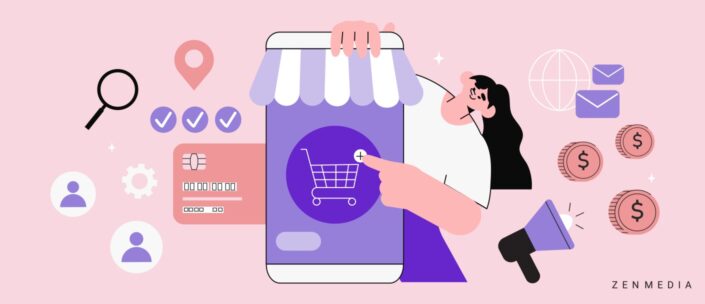While demand capture is undoubtedly crucial for sales, creating demand for your brand is equally essential.
Today’s market is full of competitors vying to attract as many consumers as possible, including members of your own target audience. Now that 2024 is underway, it’s time for B2B brands to get real about their demand-gen goals by balancing capturing demand with creating it.
B2B marketers often think capturing demand requires “converting” prospects—a sales action— but it’s not just about converting existing prospects. Capturing demand is essentially getting potential buyers interested in your solution to their problem. Once they’re interested, they’ll reach out in some way—asking for more information, a demo, or a trial. In that interaction, you can determine where they are in your sales funnel:
- They’re at the top, meaning they need the type of products or services you offer.
- They’re in the middle, meaning you’ve made their shortlist of potential providers.
- They’re toward the bottom, meaning they’re now a qualified lead.
For years, many marketers have only focused on lead generation to convert prospects into buyers, but that process doesn’t work every time, or even most of the time. In fact, according to Gartner, only 5% of the sales cycle happens with sales. The rest is the buyer interacting with marketing assets—social media content, website content, blogs, earned media, and more. While customer engagement and a strong digital presence are key factors for differentiating your business from the crowd, you have to do more to make your business known.
Related reading: The Ultimate Guide to B2B Demand Generation
What is demand creation?
Creating demand is how you drive awareness and interest in your products and services, so you don’t have to wait around for potential buyers to come to you.
If people aren’t aware, then they won’t choose your brand. Even if you have a once-in-a-lifetime product, what’s the point if there’s no demand?
Demand creation, otherwise known as B2B demand generation, aims to provide your target audience with information to help them understand why they need your product.
Not to be confused with lead generation, which concentrates on generating leads who may or may not be interested in your product or service, demand creation is about finding prospective buyers who aren’t yet aware that they need your product or service. This might be because they don’t know your product exists, or because they have a pain point but still haven’t found a way to solve it. It’s your job to convince them you’re the solution they’ve been waiting for.
Demand creation can also mean stealing some of your competitor’s market share. Maybe a prospect knows they need a CRM, but they don’t know about your CRM (or whatever product or service your brand offers).
Since they aren’t aware of your business, they already plan to settle for the default option—in this case, Salesforce.
To create demand for your product, you need to help people understand why they need your CRM, which only a few have heard of, rather than Salesforce—a famous brand everyone knows about and is the inevitable “default” choice.
By working towards creating buzz and demand for your products, rather than only capturing it, you can accelerate your business growth and expand your potential customer pool.
Capturing Demand vs. Creating Demand
Demand is at the core of every business. While both capturing and creating demand have similar processes, each activity requires a different level of effort and focus for their respective goals.
Capturing demand is all about helping those with a high level of purchasing intent move through the sales funnel to ultimately make a purchase.
This process is geared toward the mid-to-bottom section of the funnel. People in this area already have a need (demand) for your product and know about your brand. Here, the integration of Account-Based Marketing (ABM) strategies and the use of digital transformation tools, such as AI-driven personalized content and interactive platforms, can significantly enhance the effectiveness of demand capture. You’re providing targeted, personalized interactions that resonate with specific accounts and decision-makers to help seal the deal.
B2B marketing strategies for capturing demand include:
- Case studies to prove that your solutions work.
- Earned media like user reviews, influencer campaigns, placements in the press, and so on to prove that other people approve of your brand and product.
- Owned media like a strong website with detailed content about your solutions, how they work, how much they cost, how they compare to other products on the market, and so on. This will help your prospect get all of the information they need to make their choice.
The demand capture process for any business depends on how a prospect has come into contact with your product or service in the past. Demand capture focuses on convincing buyers interested in a solution to take the leap and buy something.
Related reading: Everything You Need To Know About Demand Generation
Creating demand, on the other hand, involves explicitly identifying your buyer persona’s pain points and showing how your company can solve these issues. This process occurs before capturing demand, in the top-to-mid section of the funnel, and is especially important for newer, more niche, and lesser-known businesses. This is how you reach people who don’t know about your product or brand, or understand how it can help them.
Marketing strategies for creating demand include:
- Brand awareness campaigns that help people learn about your brand and products, understand the problems you solve, and how you can help them through channels like:
- Social media
- Paid ads
- PR
- Educational resources, including blogs, long-form social content, use cases, and demos that help top-to-mid funnel prospects understand how your product differs from others, how they can use it concerning their industry, and so on.
Waiting for potential buyers to come to you is far less effective than putting in the work to create excitement, buzz, and finally, demand. Demand creation helps convince customers that your products provide viable solutions to their issues, making the capture process easier.
How to Build Your Demand Creation Strategy
With so much content readily available online, grabbing potential customers’ attention can be challenging. That’s why demand creation is so important. Here’s how you can create more demand this year.
Develop a high-quality content strategy.
One of the keys to demand generation is driving interest in your offerings. Most demand-creation tactics revolve around content creation that helps solve customers’ problems.
Because consumers get most of their information online before ever speaking with a salesperson, brands must have high-quality content that adds value by anticipating prospects’ needs and wants, and offers answers and solutions. Developing a strategy that positions you as a reliable expert in your field will help build trust between you and those interacting with your company.
Create a variety of content, from general brand awareness and prospecting to content that answers commonly asked questions. All your content should create a need for your product or service. It will differ for people who are already familiar with you and have some follow-up questions, versus a potential customer who hasn’t heard of your company.
Related reading: How to Create a B2B Demand Generation Strategy for 2023
Use an omnichannel approach.
Don’t limit yourself to one channel or format. Develop press releases, create a blog, host in-person events, or utilize social media. The key to omnichannel marketing is to ensure that your audience sees the same message regardless of the medium used to communicate. If you post something on Twitter and Facebook, ensure your message style fits both platforms, but still conveys the same idea.
As you create content, think about your target audience and ensure you are tailoring content and placing it on channels your target audience will likely look at. Remember, the goal is to generate demand—so you want to reach as many people as possible. Repurposing and redistributing your content helps you do just that.
Nurture those leads.
Most leads won’t convert right away. Instead of dismissing leads that don’t turn into customers immediately, continue to nurture that relationship—after all, you did spend time and money obtaining that potential customer.
Marketing teams should assist sales during the nurturing process, staying in touch with buyers via email, phone calls, social media messages, and conversations across multiple channels. Once you’ve created content in line with your content strategy, use those resources to stay connected with your potential customers.
Bottom line: demand creation is essential for growing your brand.
While CEOs and CFOs will inevitably focus on capturing demand—as it’s the last step before making a sale—it’s important to remember that if you don’t invest in creating demand, you won’t have any demand to capture.
Companies can’t focus on either demand generation or capture; they need a strategy that prioritizes both areas.
Need help creating demand for your brand? Let’s chat!







